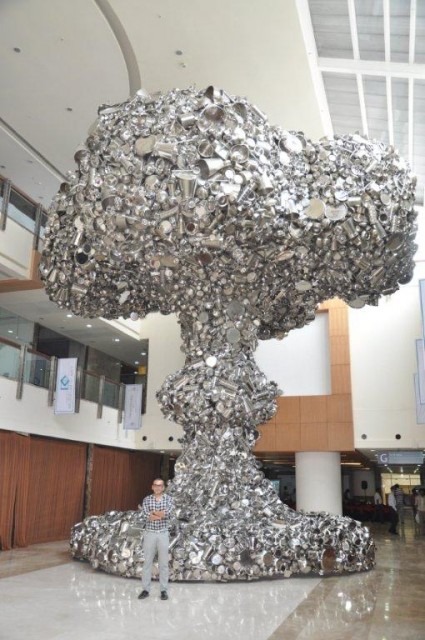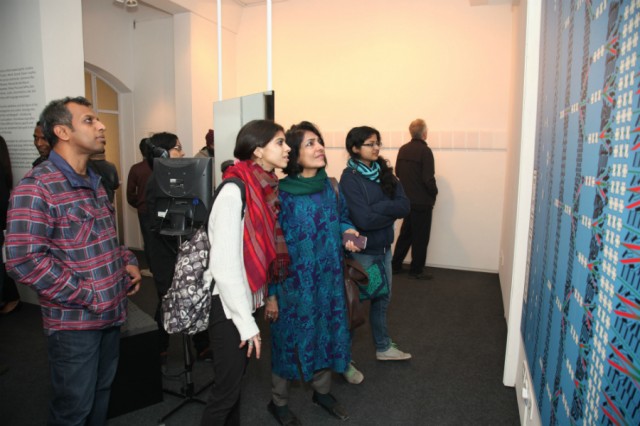Field Trip: Discovering Delhi’s Art Scene

Unable to visit New Delhi and explore in person? Emma Sumner takes us on a tour of the most exciting art spaces India’s capital has to offer…
New Delhi is the rapidly pulsating heart of India; hot, humid, heavy with noise and dust, its fast paced yet laid-back attitude make it a city like no other, somewhere that will excite and entice those brave enough to meet its bustling culture head-on. A thriving art scene can be found, but seeing as the majority of Delhi’s most exciting venues aren’t listed in your typical travel guide, a little investigation is required to discover its hidden gems.
For those willing to take the time, opportunity abounds to discover artists you may not have previously had the pleasure of knowing, and find out what it is that makes India’s artistic heart beat so furiously.
It isn’t a surprise that New Delhi, as India’s capital, is home to the National Gallery of Modern Art (NGMA). A sprawling space full of countless paintings and sculptures by well-respected Indian artists, it’s a great place to immerse oneself in the country’s cultural aesthetic. The collection only has a limited representation of contemporary artwork, despite a towering sculpture by Hauser & Wirth artist Subodh Gupta, which stands over the external courtyard.
At first glance, the Delhi Art Gallery appears similar to the NGMA, but actually reveals itself to be a private commercial enterprise. Dealing only in historical works, the gallery has a huge collection, curating exhibitions that encourage strong critical debate. However, despite inviting audiences down the rabbit hole of India’s artistic heritage, neither of these galleries tell us much about flourishing independent or contemporary scenes.
Mostly, the best of India’s upcoming talent can be found in the numerous independent commercial galleries run by private individuals. In recent years, the area of Lado Sarai has seen a large number of such places spring up along its bustling main street; one of which is the internationally acclaimed Latitute 28. Run by Bhavna Kakar, Latitude has been supportive to artists, helping those within its portfolio to further their careers by supporting the production, presentation and accession of their work.
As Kakar explains: “Latitude 28, around the time it started out, was part of a cultural wave in New Delhi that breathed life into a contemporary art scene that had become slightly dull, dampened by the declining market of the time. It looked for new modes of presentation, fresh perspectives, and emerging artists with work that challenged the boundaries of market that was based on easily collectible art, for such times are also a great opportunity to take chances.”

Representing a diverse portfolio of Indian artists working in a variety of media — from traditional to video and performance — the gallery is a hub of critically engaged practice.
Of course, there are a lot of commercial spaces selling typical ‘living room art’, but across Delhi there are a large number of standout galleries representing the very best of the local arts scene, including the Vadehra Art Gallery, Talwar Gallery and Gallery Nature Morte. The latter is run by Peter Nagy, who first founded the gallery in New York’s East Village in 1982; after a period of closure and a move to Delhi, he revived Nature Morte in 1997.
A commercial and experimental space, Nature Morte’s portfolio comprises mostly of the celebrated generation of Indian artists who have gone on to international exposure, and boasts some of most synonymous Indian artists working today; the aforementioned Subodh Gupta, technicolour sculptor Arun Kumar HG, and painter Josh PS. Comparable in feel to an artist’s residency space, the gallery’s white walls have a homely and welcoming atmosphere, providing visitors with a comfortable environment to fully engage with the artworks.
Moving away from the commercial to the independent, KHOJ International Artists’ Association is a space for arts incubation and experimental and critical art practice in India. Founded in 1997 as an annual workshop, today KHOJ is a permanent base from which to operate a residency programme: artists live, work and collaborate here.
As Project Manager Sitara Chowfla explains: “In terms of artist support there is a lot that KHOJ does; we are not only providing the artists with facilities, space and means to produce work, but also offer curatorial support and engage the artists into a wider network. This is something a lot of organisations don’t do. Additionally, once an artist has been in residency here or has participated in a KHOJ programme, they are part of the family and often come back, to be part of a residency again… or return at a later stage of their career to show work here.”
KHOJ’s residencies are open to international applications, inducting a variety of artists into the warmth of Delhi’s art scene. Without a permanent gallery space, KHOJ’s appeal comes in the form of open studios, where the public are invited to view the experimental environment selected artists have been working within for the duration of their residency.

Two of Delhi’s most respected spaces actively collecting and displaying work are the privately owned Kiran Nadar Museum of Art (KNMA) and the Devi Art Foundation. KNMA was founded in 2010 by the avid collector Kiran Nadar as a non-profit, ‘people-centred’ organisation with a clear focus on instilling art appreciation amongst the public. Tucked away behind the oppressively westernised Saket Walk Mall, the gallery is a striking space for exploring the vast collection of modern and contemporary art from India and the Subcontinent. The gallery’s exuberant collection policy ensures that the works of contemporary artists working today are added to its collection, filling the contemporary art gap left by NGMA. Centred around all of this activity is an active schools programme, introducing great works to the next generation; something that so far appears to be lacking in Delhi as a whole.
The Devi Art Foundation doesn’t have as active an exhibition programme as KNMA, but around its small programme hosts a series of small seminars, film screenings, artist’s talks and an active learning programme. Established as a permanent space in 2008, the foundation cares for Lekha and Anupam Poddar’s vast collection of artworks. Based in Gurgaon, a place often described as a satellite city to Delhi, this buzzing commercial hub is a bit of a hike to get to, but the architecture of the space alone (based in the family’s corporate offices) makes it worthwhile. On top of the Poddar family’s active collecting, Devi also commissions new work by emerging artists, actively partnering with collectives to source and purchase new works; an important and crucial boost for artists in a country without public funding akin to the UK’s Arts Council.
Although most of these spaces are not on your everyday tourist map and slip easily into hidden pockets of the city, Delhi’s art scene is a thriving and amazing world ripe for exploration. What you will find is very different to anything the UK has to offer: a fascinating display of art by artists with a diverse cultural background and experience, producing work of much impact and distinction.
Emma Sumner





